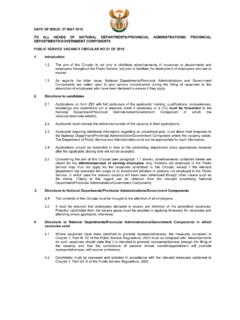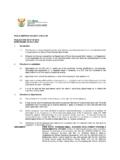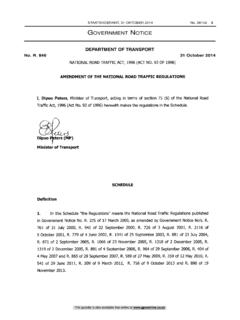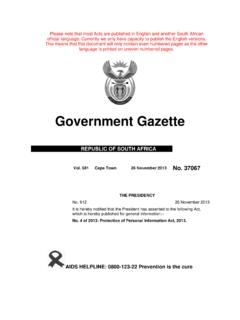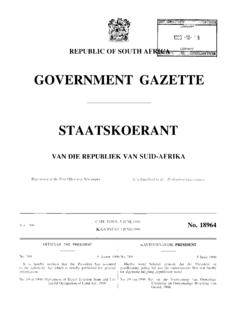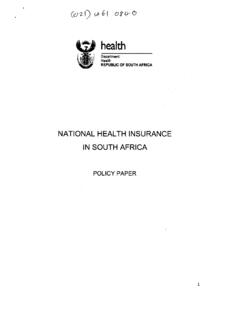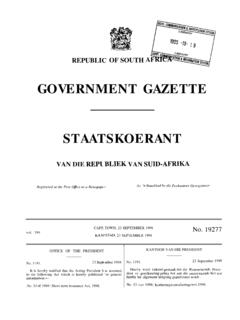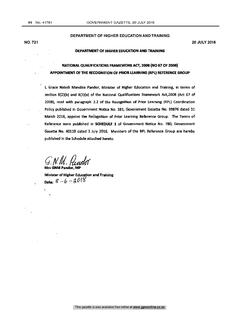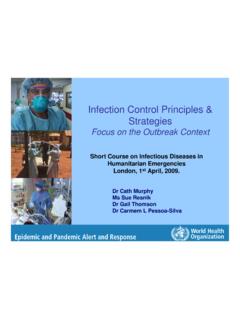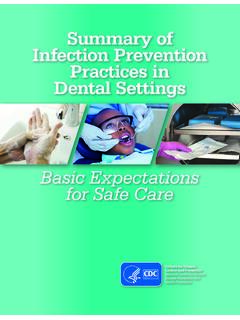Transcription of Guidelines for schools on maintaining hygiene during the ...
1 1 Guidelines for schools on maintaining hygiene during the COVID-19 pandemic 2 Guidelines for schools on maintaining hygiene during the COVID-19 pandemic TABLE OF CONTENTS ACRONYMS 3 PURPOSE OF THE Guidelines 4 A UNDERSTANDING COVID-19 4 B STANDARD PRECAUTIONS OF INFECTION PREVENTION AND CONTROL 6 C RISK REDUCTION METHODS FOR schools 7 D RISK REDUCTION METHODS FOR CLASSROOMS & OFFICES 8 E RISK REDUCTION METHODS FOR TOILETS/ BATHROOMS 8 F HAND hygiene PRACTICES 9 G FOOD PREPARATION AREAS ( schools WITH NSNP) 11 H LEARNER TRANSPORT 11 I CONSISTENT AVAILABILITY OF hygiene PRODUCTS 12 J CLEANING AND DISINFECTION 13 K USE OF INFORMATION, EDUCATION AND COMMUNICATION MATERIAL 16 APPENDIX 1: BASIC hygiene AND SANITATION PACKAGE FOR EACH school 17 APPENDIX 2: Guidelines ON USE OF PERSONAL PROTECTIVE EQUIPMENT 18 APPENDIX 3: HOW TO PUT ON, USE AND TAKE OFF OF A MASK 20 APPENDIX 4.
2 HOW TO CONSTRUCT SELF-MADE HANDWASHING FACILITIES 21 3 Guidelines for schools on maintaining hygiene during the COVID-19 pandemic ACRONYMS COVID-19 Coronavirus disease 2019 DBE Department of Basic Education DoH Department of Health DoT Department of Transport DPSA Department of Public Service and Administration DSD Department of Social Development EOC Emergency Operations Centre EPWP Expanded Public Works Programme NDoH National Department of Health NICD National Institute for Communicable Diseases NSNP National school Nutrition Programme OHSA Occupational Health and Safety Act PED(s) Provincial Education Department(s) PHEIC Public Health Emergency of International Concern PPE Personal Protective Equipment PUI Person Under Investigation SARS-CoV-2 Severe Acute Respiratory Syndrome Coronavirus 2 SBST(s) school -Based Support Team(s) SMT(s) school Management Team(s) SOP(s) Standard Operating Procedure(s) TB Tuberculosis WHO World Health Organization 4 Guidelines for schools on maintaining hygiene during the COVID-19 pandemic PURPOSE OF THE Guidelines hygiene interventions play an important role in reducing and preventing the spread of the COVID-19 virus, and in developing the necessary knowledge to positively impact attitudes of personal and community hygiene practices.
3 These Guidelines provide recommendations on hygiene measures to be implemented in the school environment, in order to prevent and reduce the spread of COVID-19. These measures include the use of Personal Protective Equipment (PPE), social distancing and hand hygiene practices. school hygiene measures should include education and awareness of educators, learners and school support on COVID-19, the spread of the virus, symptoms thereof and personal protective measures. Importantly, these hygiene practices should continue outside of the home in households and in learner transport in order to keep the school community safe. A. UNDERSTANDING COVID-19 What is COVID-19? COVID-19 is a respiratory illness caused by a novel (new) virus, and we are learning more about it every day.
4 There is currently no vaccine to protect against COVID-19. Thus, the best way to prevent infection is to avoid being exposed to the virus that causes it. Stopping transmission (spread) of the virus through everyday practices is the best way to keep people healthy. More information on COVID-19 is available from the National Institute of Communicable Diseases ; the Department of Health and the Department of Basic Education . schools , working together with local health departments, have an important role in slowing the spread of diseases to help ensure learners and educators have a safe and healthy learning and working environment. How is the corona virus spread? 5 Guidelines for schools on maintaining hygiene during the COVID-19 pandemic COVID-19 is spread by fluid droplets when coughing, sneezing or talking.
5 It can be spread by a person who has been infected before they have symptoms, during illness and for a short period of time after they feel better. Researchers estimate that around 44% of infections are passed-on by people who are not showing any symptoms. Virus particles can survive in the air for a short period of time and can remain on hard surfaces such as plastic or steel for a few days, if not removed with regular cleaning. COVID-19 is spread by contaminated hands touching the hands of others or touching things such as money, credit cards, door handles and counters. When you then touch your eyes, nose and mouth after you have touched other people s hands and things with COVID-19 on it, then you can get infected. What are the symptoms of COVID 19? B. STANDARD PRECAUTIONS OF INFECTION PREVENTION AND CONTROL 6 Guidelines for schools on maintaining hygiene during the COVID-19 pandemic A safe environment can be achieved through elimination of infectious particles in the air and on surfaces by always adhering to the Golden Rules: 1.
6 Prevent direct contact with persons who are sick encourage educators, learners and staff to stay at home when feeling sick. 2. Use of personal protective equipment (PPE) use protective face masks at all times. 3. Environmental cleaning and disinfection - reduce the risk of micro-organisms in the environment by cleaning and disinfecting frequently touched surfaces such as door handles, hand rails, desks, tables, windows, etc. hourly or less frequently depending on the circumstances. An effective disinfectant is diluted bleach disinfectant (20 ml bleach per litre of clean water). 4. Social distancing - Keep a distance of at least meters between persons where possible, avoiding gatherings and contact activities outside of the classroom such as extra mural activities, contact sport, assemblies, hall gatherings and queuing at tuck-shops or for school feeding programme meals.
7 5. Hand hygiene - Wash hands frequently with soap and water for 20 seconds, especially after using the toilet, touching food and if hands are visibly soiled/dirty. 6. Use alcohol-based hand sanitiser regularly, especially after contact with any person or after contact with frequently touched surfaces phones, door handles etc. 7. Avoid touching your eyes, mouth, or nose with unwashed/un-sanitised hands. 8. Limit airborne transmission- allow adequate cross ventilation in classrooms and office buildings. Limit visitors and the number of people that enter the school , office or classroom. Parents should enter the school only if absolutely necessary. Practice cough and sneeze etiquette cough in the fold of the bent elbow and sneeze in a tissue which should be discarded safely in a refuse bin with a lid.
8 Wash hands immediately thereafter. C. RISK REDUCTION METHODS FOR schools 7 Guidelines for schools on maintaining hygiene during the COVID-19 pandemic a) Every person (parent, teacher, learner or visitor) that enters or leaves a school must wash their hands or sanitise them at the entrance/gate utilising hand hygiene stations equipped with soap (bar or liquid) and water or sanitise with a hand sanitiser with at least 60% alcohol base. b) Pens and pencils must not be shared amongst learners or teachers. c) There should be no sharing of food or eating utensils. d) Social distancing must be adhered to at all times. e) Classrooms must be well ventilated. f) Classrooms must be cleaned at least twice a day with a disinfectant. g) Every person (parent, teacher, learner or visitor) that enters a school should have their temperature assessed with a digital thermometer scanner as follows.
9 O Remove the protective scanner cap o Switch the scanner on and wait for the 00 reading o Scan the forehead of the person o A reading of 38 degrees Celcius and above indicates a possible fever and should be referred for further investigation, as per the DBE Standard Operation Procedure for the Prevention, Containment and Management of COVID-19 in schools and school Communities- hereafter referred to as the SOPs ) o Visitors and staff with a fever are not permitted on the school grounds. o Learners with a temperature of more than 38 degrees must be kept separate from other and isolated in the designated isolation space, equipped with a mask and the parents/caregivers notified to collect the child for further investigation by a health professional. The principal or his/her designate must contact the school health contact person or the nearest public primary healthcare facility.
10 The health facility must be informed if a COVID-19 infection is suspected so that the facility can make the necessary arrangements to receive and manage the patient safely to prevent contamination. NB: Each person conducting screening must wear a face mask and must regularly wash their hands for 20 seconds or use a hand sanitiser (at least 60%alcohol) during the course of screening. Social distancing must be observed at all times. 8 Guidelines for schools on maintaining hygiene during the COVID-19 pandemic D. RISK REDUCTION METHODS FOR CLASSROOMS & OFFICES Each classroom and office must have access to the following: a) A portable handwashing station (avoid common bowls use tippy taps), handwashing soap (bar or liquid) or hand sanitizer with at least 60 % alcohol base. Frequent hand hygiene must be part of the routine of everyday life in a school or office.
